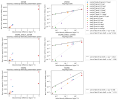Hi MOM6 folk, I've got some idealized MOM6 ice shelf cavities running, based on the MOM6-examples ISOMIP examples. With thermodynamics turned on it works quite nicely and gives nice melt patterns and circulations. However, when thermodynamics is turned off I still see quite large spurious velocities emerge in multiple types of vertical coordinates.
We've tried turning KV_ML_INVZ2 = 0, which was an issue that got resolved last year, but unfortunately, we still have quite large (order cm/s) velocities emerging in both the ISOMIP+ case and other configurations I have set up. See this repo for configs and this notebook for some plots. The following plot shows the maximum horizontal speed in the unforced ice shelf cavity, where we expect velocities created from the imperfect ice shelf initialization to decay, and instead, they grow, particularly for the models run in sigmazstar and sigma (terrain or ice-shelf draft following) coordinates.

Does anyone have any ideas about how to reduce these spurious velocities or what could be going wrong (either in this config or in the model)?
We've tried turning KV_ML_INVZ2 = 0, which was an issue that got resolved last year, but unfortunately, we still have quite large (order cm/s) velocities emerging in both the ISOMIP+ case and other configurations I have set up. See this repo for configs and this notebook for some plots. The following plot shows the maximum horizontal speed in the unforced ice shelf cavity, where we expect velocities created from the imperfect ice shelf initialization to decay, and instead, they grow, particularly for the models run in sigmazstar and sigma (terrain or ice-shelf draft following) coordinates.

Does anyone have any ideas about how to reduce these spurious velocities or what could be going wrong (either in this config or in the model)?



